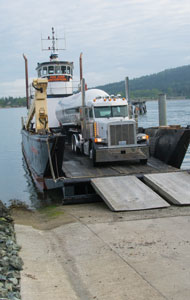Young people growing up on Puget Sound and coastal British Columbia in the 1950s and ’60s could attend a Saturday afternoon movie to see landing craft carrying Marines to amphibious landings on beaches in the South Pacific. They could then walk down to their local dock and see the same craft, or a modified version, loading cargo to take to one of the small islands that dot the coast. Made of plywood at the Higgins Industries shipyard in Louisiana, these boats were only 36 by 10 feet and typically were powered by a single 250-horsepower Gray Marine 6-71 diesel.
By the 1980s and ’90s, the children of these young people would have seen the first surplus Vietnam War-era LCM-8s (landing craft mechanized) showing up at their local docks. These 74-by-21-foot vessels were, and often still are, powered by a pair of Detroit 12V-71 engines. The commercial mariners of the Pacific Northwest were quick to add their own modifications to these versatile boats. The most important was a full aft accommodation block with a galley and bunks down and wheelhouse up.
A good many of these landing craft, especially the LCM-8s, are still working in the Pacific Northwest and around the world. Capt. Dan Crookes owns and operates a particularly fine example out of Anacortes, Wash. Built for the Vietnam War in 1968 by Higgins Industries, developers of the original wooden World War II craft, Crookes’ welded steel boat sat, mothballed and engineless, at the Higgins yard until 1989. Finally, it was given a pair of Detroit 12V-71 engines and was briefly stationed in Tacoma as an Army training vessel. It was then sold at auction to buyers who brought it to Orcas Island in Puget Sound’s San Juan Islands. These civilian owners lavished nearly $1 million on the boat. Most significantly, they had a 24-foot section added amidships to stretch it to 98 feet long. They also added an accommodation block with a galley. They topped it with a handsome West Coast-style wheelhouse salvaged from a sunken Alaska limit seiner, which also provided a Skookum anchor winch. The winch now holds pride of place on the stern deck for the transom-mounted emergency anchor.
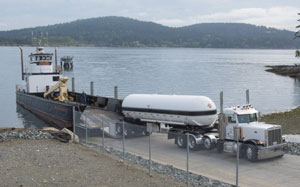 |
|
San Juan Enterprise takes on a tractor-trailer and its cargo of propane at Anacortes, Wash. The former LCM-8, built for the Vietnam War, provides access to communities in the San Juan Islands that are not served by ferries. |
The result is a good-looking boat with 64.5 feet of usable cargo space that is U.S. Coast Guard certified to haul flammable liquids. Previously, Crookes had operated a freight business in the San Juan Islands but sold it to concentrate on cruising with his own sailboat and crewing on trans-ocean races. When the refurbished San Juan Enterprise came on the market at an attractive price in 2007, he decided that it was the right time and the right boat to buy back into the business. With a partner, he formed San Juan Marine Freight, based in Anacortes.
There are about 170 named islands in the San Juans, some with ro-ro ferry access and most without. The islands are dotted with some of the most expensive recreation and retirement homes in the country. All of the construction material, from concrete for the foundations to shingles for the roofs, has to be hauled in by water. On the few larger islands, some products will come by ferry, but dangerous cargoes such as propane, gasoline and jet fuel must come by approved vessels. Several fish farms set among the islands have their regular supplies of feed, in 2,000-pound bags, shipped on Crookes’ landing craft. The bags are primarily loaded by forklift but also can be moved on board by the hydraulic crane mounted on the forward starboard bulwarks. Other regular cargo includes cement trucks that, despite new drivers’ reservations, can be loaded two at a time.
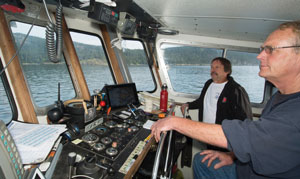 |
|
Truck driver Rick Lowes, left, visits the wheelhouse to hear sea stories from Capt. Dan Crookes, who owns and operates the vessel. |
“We have a 15-foot pinch point forward,” Crookes explained, “but when the boat was lengthened they cut away quite a bit of the wide bulwarks to (provide) more cargo space. I show the drivers a photo of two cement trucks fitted into the available space at an angle and then they make their trucks fit.”
The limits as to what can be carried on ferries create an important niche for landing craft in the San Juan Islands. Crookes has contracts to carry loaded tractor-trailers with flammable cargoes to the islands. On a recent trip involving propane, he ran San Juan Enterprise to the Port of Anacortes beside the Dakota Creek Industries shipyard at 0700. With the forward ramp down, including two permanently affixed aluminum extensions, the boat was ready to load. Right on schedule, driver Rick Lowes backed his semi onto the vessel with directions from Crookes, who asked him to place the 86,000-pound rig closer to the boat’s centerline. The trucks are fitted with pad eyes that can be lashed to D-rings welded to the bulwarks just above the deck, but these were not needed on this virtually windless day.
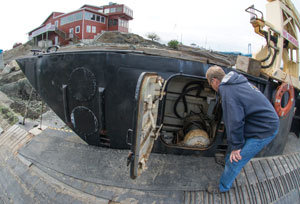 |
|
Crookes examines the hydraulic winch for raising and lowering the landing craft’s ramp. One of the boat’s primary jobs is transporting construction materials for upscale homes, like the one in the background, that dot the San Juan Islands. |
With the truck loaded, Crookes backed into Guemes Channel and turned westward along the Anacortes waterfront to begin the 1.5-hour run to Friday Harbor on San Juan Island. The boat would cross Rosario Strait and enter Thatcher Pass between Decatur and Blakely islands. At 0810, as San Juan Enterprise entered the narrow pass, Lowes came up to the wheelhouse and Crookes pointed out a pair of multimillion-dollar homes on the beach on Blakely Island to starboard. “We hauled all the building materials for those houses,” he said. “We were able to get special permission to land on that gravel beach because there is no ferry service to the island.”
Once through Thatcher Pass, Crookes turned north to follow the maze of channels around the top end of Lopez Island. The boat was making just over 9 knots at 1,500 rpm. “When the military had her, they had big injectors and made 10 knots wide open, even though the shorter 74-foot boat had a hull speed of only about 7.5 knots. But they burned 38 gallons per hour,” Crookes said. “Now, with the lengthened hull, I have installed smaller injectors and can make the 9.5-knot hull speed at only 1,500 rpm on the 12V-71s.”
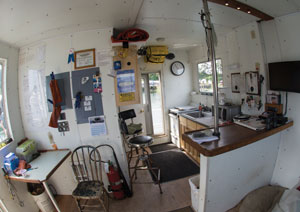 |
|
While utilitarian, the galley, below, affords all the comforts of home. It was added during a renovation that included lengthening the boat from 74 feet to 98 feet. |
Crookes calls the stretch of relatively open water in central Rosario Strait, from Shannon Point to James Island and Reef Point, the “Rosario Triangle.” In winter, winds from the southeast can push fiercely against the ebb tide flowing from several directions at once, creating steep seas that require cargoes such as the propane truck to be lashed down. If the seas are severe enough, Crookes will take a longer alternate route north through Peavine Pass.
At 0900, still making 9.5 knots, the boat flowed through Canoe Pass in Upright Channel. Although narrow, most of these channels are deep and many, such as Canoe Pass, are on the regular ferry routes. With a loaded draft of only 4.5 to 5 feet, San Juan Enterprise can take an occasional shortcut through a shallow area. The shores are mostly forest-covered and steep, regularly opening to spectacular bays and beaches. It is easy to see why some of the wealthiest Americans have built summer homes here.
As the landing craft entered Shipyard Bay on the south side of Friday Harbor at 0945, Crookes admired some of the restored classic boats there, including Teal, a former Alaska fisheries patrol boat designed by H.C. Hanson and built in 1927, and the 32-foot troller Molle B., built in 1939. “I almost bought that one recently,” he mused.
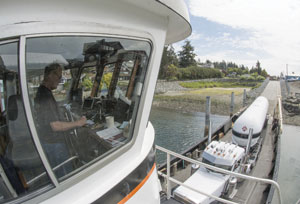 |
|
With Crookes at the helm, San Juan Enterprise arrives back at Anacortes after carrying its propane cargo to Friday Harbor on San Juan Island. Trucks can be lashed to D-rings on the bulwarks above the deck in the event of heavy weather. |
Fitting between the docks filled with pleasure boats to starboard and a larger fishing boat moored to port, the landing craft eased into the concrete ramp on the shore. The tide was near the low water mark and Crookes used the single lever control on the wheelhouse dashboard. As he pushed the lever forward, the dogs that lock the ramp in the raised position lifted and a 60-foot cable that passes through the ramp began to pay out from a hydraulic drum inside the starboard forward bulwarks. Once the ramp was lowered, the propane truck was able to drive directly off to make a delivery on the other side of the island.
An airline pilot who lives on the island soon came aboard to talk with Crookes. Business in the San Juans is dependent on a network of customers among the island communities, and word of good service and personal attention spreads quickly. After the pilot left, Kevin Martin, owner of a smaller landing craft named Pintail, came aboard. Crookes had opened the engine room hatch in the afterdeck. The hatch led to a lazarette, then through a door to the comfortable spaces around the twin engines. After seeing that all was OK, he came up to sit in the May sun and talk shop with Martin, who moors his landing craft and his live-aboard boat on a nearby float.
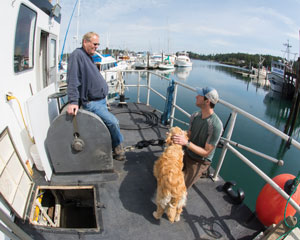 |
|
Crookes and Kevin Martin, the owner of a smaller landing craft that services the area, relax on the back deck of San Juan Enterprise with Crookes’ dog. |
A good bit of the talk revolved around the challenges of access, either via a proper concrete loading ramp or onto the beach. Landings on beaches are controlled by ever more stringent regulations. The concrete ramps are a mix of public and private. They all require a payment, generally on an honor system. The shore ramps also vary in quality and ease of access. Crookes has modified his boat’s ramp by extending the supplemental aluminum sections and by adding D-rubber fendering on the bottom of a set of “feet” attached to the leading edge of the steel part of the ramp. This D-rubber, together with the weight of the ramp, effectively holds the landing craft in place while loading.
Talking shop in the sunshine is a pleasant way to pass an hour or so, but Martin had work to do on Pintail and Crookes’ now-empty propane truck had returned. It drove straight onto the boat, as it is easier to back off on the Anacortes side. Crookes explained to the driver that when an offshore wind is blowing it can be tricky to back out of the harbor between the fish boats at the dock and the sailboats on the floats, but on this bright day all flowed with ease.
Over the next hour and a half, they retraced their route through the spectacular San Juan Islands and back to Anacortes. By 1430, San Juan Enterprise, which began life as a Higgins LCM-8 in Louisiana, was secure at the company dock and Crookes was taking phone calls to arrange the next day’s voyage and to book work two weeks ahead. With his office work done, he mused that at the age of 61 and having been in the marine business since 1984, he was now interested in finding a working partner to buy into the boat and eventually buy him out — a great gig for the right person.

